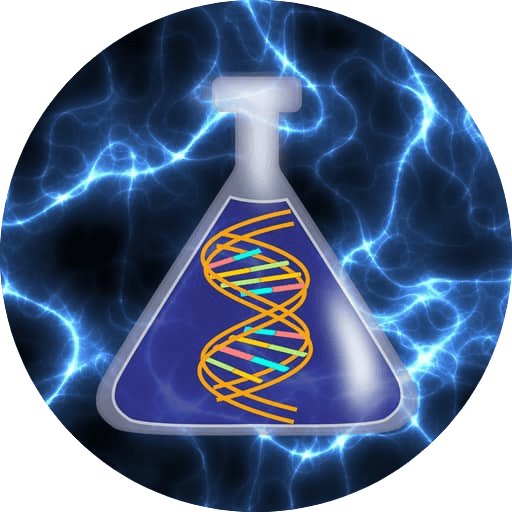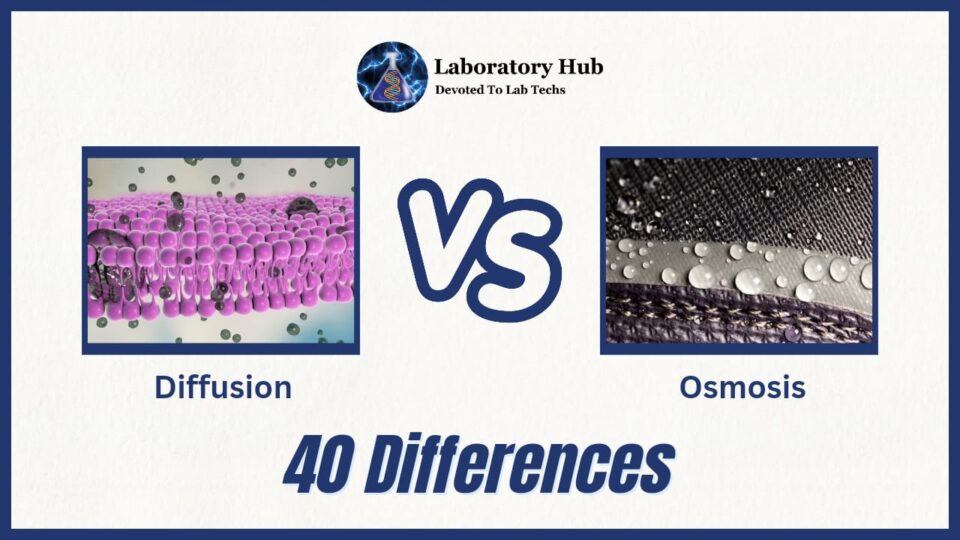Diffusion and osmosis are both basic biological procedures in which molecules or materials flow through cell membranes. They perform critical roles in cellular homeostasis and are required for a variety of physiological processes in living organisms.
DIFFUSION
Diffusion is a physical process that occurs when particles, such as molecules or ions, travel from a high concentration area to a low concentration area. This movement happens on its own and is caused by particles’ natural urge to spread out and become uniformly dispersed within a particular space. Diffusion is a passive process that requires no energy to operate.
The concentration gradient, or the differential in concentration of a material between two locations, is the driving force behind diffusion. There are more particles accessible to randomly travel, collide, and spread out in locations where a chemical concentration is higher. As particles move at random, they gradually disperse themselves in such a way that an even concentration is achieved over the available space.
Diffusion is a fundamental process that occurs at numerous stages in daily existence, from the molecular level to larger scales. Diffusion can be seen in the spread of food aromas throughout a room, the mixing of two different liquids, and the exchange of oxygen and carbon dioxide between the lungs and bloodstream during respiration.
OSMOSIS
Osmosis is a sort of diffusion that occurs when water atoms travel through a semipermeable membrane. A semipermeable membrane permits certain substances, such as water, to pass through while preventing the passage of others. Osmosis occurs when the concentration of solutes (substances dissolved in the solvent, usually water) on each side of the membrane differs. In an attempt to equalise the solute concentration on both sides of the membrane, water travels from a lower solute concentration area to a higher solute concentration area.
At one stage osmosis results in the formation of an equilibrium in which the concentration of water molecules on both sides of the membrane is the same. Water particles continue to travel in both directions across the membrane at this moment, but there is no net movement of water, and the overall water concentration remains constant.
Also Read: Agglutination vs Precipitation- 20 Differences
Here are 40 differences between diffusion and osmosis:
|
S.No. |
Aspects |
Diffusion |
Osmosis |
|
1 |
Definition |
Movement of particles from an area of higher concentration to lower concentration |
Movement of solvent (usually water) from an area of lower solute concentration to higher solute concentration through a semi-permeable membrane |
|
2 |
Type of Substances |
Involves the movement of solute particles |
Primarily involves the movement of solvent molecules |
|
3 |
Driving Force |
Driven by concentration gradients |
Driven by differences in solute concentration |
|
4 |
Membrane Requirement |
Can occur in the absence of a membrane |
Requires a semi-permeable membrane |
|
5 |
Direction |
Occurs in all directions |
Typically involves solvent moving into the more concentrated solution |
|
6 |
Rate |
Generally faster than osmosis |
Generally slower than diffusion |
|
7 |
Affected by Temperature |
Affected by temperature (increased temperature speeds up diffusion) |
Affected by temperature (increased temperature speeds up osmosis) |
|
8 |
Examples |
Perfume spreading in a room, sugar dissolving in water |
Water moving into or out of plant cells, red blood cells in hypertonic solutions |
|
9 |
Importance in Biology |
Essential for various cellular processes |
Crucial for maintaining cell turgidity and proper functioning |
|
10 |
Particles Moved |
Any type of solute particles (e.g., ions, molecules) |
Primarily involves water molecules |
|
11 |
Facilitated by |
Facilitated by a concentration gradient |
Facilitated by a difference in solute concentration |
|
12 |
Net Movement |
Can result in a net movement in any direction |
Generally results in a net movement of water into the more concentrated solution |
|
13 |
Reverse Process |
Can involve reverse diffusion |
Osmosis in reverse can occur (reverse osmosis) |
|
14 |
Size of Particles |
Can involve particles of various sizes |
Primarily involves smaller water molecules |
|
15 |
Impact on Solutions |
Tends to equalize solute concentrations |
Tends to equalize solute concentrations, affecting solution properties |
|
16 |
Role in Biological Systems |
Plays a role in gas exchange in respiration |
Critical for water transport in plants, kidney function, and cell hydration |
|
17 |
Molecular Movement |
Involves the movement of individual solute molecules |
Primarily involves the movement of solvent molecules in clusters |
|
18 |
Selectively Permeable Membrane |
Not required; can occur in open systems |
Requires a selectively permeable membrane |
|
19 |
Experiments |
Demonstrated with diffusion in gases or liquids |
Demonstrated with osmosis in solutions with semi-permeable membranes |
|
20 |
Colligative Properties |
Affects colligative properties of solutions |
Affects colligative properties of solutions, particularly lowering the vapor pressure |
|
21 |
Equilibrium State |
Eventually reaches equilibrium |
Can reach equilibrium or continue if the solute concentration gradient persists |
|
22 |
Affected by Pressure |
Affected by pressure differences in gases |
Less affected by pressure differences |
|
23 |
Application in Dialysis |
Used in dialysis to remove waste products from blood |
Utilized in dialysis to remove excess solutes from blood |
|
24 |
Movement in Cells |
Involves solute movement within and between cells |
Crucial for water movement into and out of cells |
|
25 |
Role in Kidney Function |
Important for solute exchange in nephrons |
Critical for urine formation and waste removal in the kidneys |
|
26 |
Role in Plant Physiology |
Less significant for plants in comparison to osmosis |
Essential for plant turgor pressure, nutrient uptake, and cell structure |
|
27 |
Impact on Cell Shape |
May not significantly affect cell shape |
Can affect cell shape and volume |
|
28 |
Influence on Water Potential |
Doesn’t directly influence water potential |
Can significantly affect water potential |
|
29 |
Role in Food Preservation |
Used for processes like drying and salting |
Osmotic pressure used in food preservation techniques like pickling |
Also Read: Check out the Principle, Preparation & Uses of Anticoagulants in Hematology Laboratory
Frequently Asked Questions (FAQS)
Q.1 What is the definition of a selectively permeable membrane?
A selectively permeable membrane is a barrier that permits some chemicals to pass through while blocking others. It allows individual molecules or ions to move according to their size, charge, or other features.
Q.2 How does particle size affect diffusion and osmosis?
Smaller particles diffuse faster than larger particles because they have greater kinetic energy and move faster. The concentration gradient of solute particles, rather than the size of the solute particles themselves, influences the movement of water in osmosis.
Q.3 . What exactly is a concentration gradient?
The difference in concentration of a material between two regions is referred to as a concentration gradient. Diffusion and osmosis take place along concentration gradients, with nanoparticles moving from regions with greater concentrations to lower concentration areas.
Q.4 What factors influence diffusion rate?
The temperature (higher temperatures boost diffusion rates), gradient of concentration (larger gradients lead to more quickly diffusion), area of the surface (larger surface areas enable for more diffusion), and the properties of the material being diffused (size, charge, and solubility) are all factors that influence the rate of diffusion.
Q.5 Is osmosis possible in gases?
Yes, osmosis can take place in gases. It entails the transfer of gas molecules from a higher concentration location to a lower concentration area via a selectively permeable barrier.
User Review
( vote)
Laboratory Hub aims to provide the Medical Laboratory Protocols & General Medical Information in the most easy to understand language so that the Laboratory Technologist can learn and perform various laboratory tests with ease. If you want any protocol to be published on Laboratory Hub, Please drop a mail at contact@laboratoryhub.com. Happy Learning!

